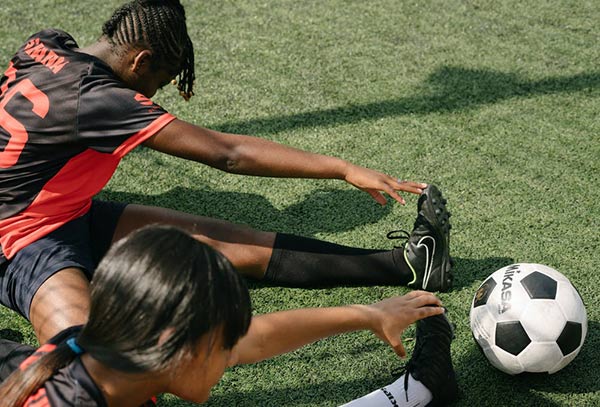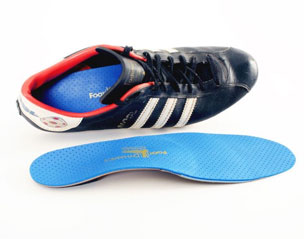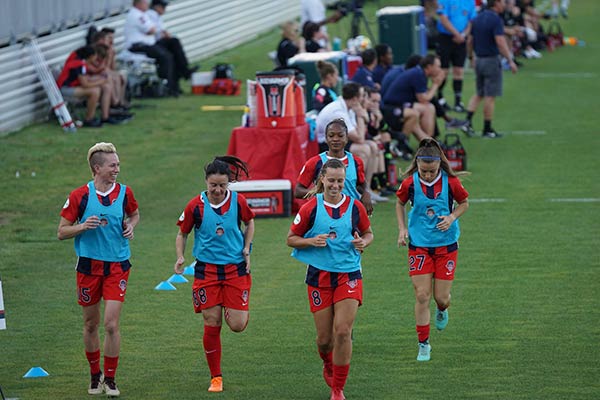4 Easy Steps to Reduce the Risk of Soccer (Football) Injuries

With the Canberra football (soccer) season underway this year, this is a timely reminder about the potential risk for soccer injuries and how to avoid them. The start of the soccer season means a rise in lower limb muscle injuries at Sport and Spinal Physiotherapy – for juniors and seniors football players alike. A classic example in the clinic came just the other week where a male player came in citing he had done “nothing” at all in the off season, went to a 2 hour training session, and by the time he woke up the next day, couldn’t walk. Another case in point was a female player who was late to the start of a game, hurried onto the pitch and then felt her hamstring “grab” in the first 5 minutes. Has this happened to you?
Gungahlin United Football Club
Firstly, a huge congratulations to Gungahlin United Football Club for reaching the pinnacle of A.C.T. football, the Premier League, in which their debut season has taken flight. Secondly, with a record number of players at the club this year (1500), this solid supporter base will ensure GUFC will have a massive presence in the capital this season.
With the congratulations out of the way, this is what I’ll be covering in this article;
1. Types of Lower Limb Soccer Injuries
2. Approaches to Preventing Lower Limb Injuries in Soccer – Football
Step 1: Orthotics
Step 2: Correct Training and Bio-mechanical Analysis
Step 3: The FIFA 11+ Program to Prevent Football Injuries
Step 4: Taping and Bracing Techniques
3. Treating a Lower Limb Football Injury
Types of Lower Limb Soccer Injuries
Lower limb muscle injuries can have a profound impact on how your individual football season pans out. The most common type of lower limb injuries in soccer are sprains and strains. Apart from the typical ankle sprain and muscle tears in the calf and thigh, other injuries can include cartilage tears and anterior cruciate ligament (ACL) sprains in the knee.
Soccer players can also suffer from Achilles tendinitis, patellar tendinitis and shin splints through overuse or improper biomechanics technique.
Approaches to Preventing Lower Limb Injuries in Soccer – Football
Step 1: Orthotics

Our therapists have extensive knowledge in correctly diagnosing predisposing factors that can lead to serious injuries. We work together as a team to use this knowledge for the client’s benefit.
In the last month alone, I have referred a number of teenage clients to our on-site podiatrist to prevent the impact of lower limb biomechanical issues from being as damaging as they potentially could be.
As part of this process, not only are these issues viewed within the sporting context, but also applied to everyday life where custom-made orthotics are implemented to school shoes and joggers alike. This has made a significant improvement on their biomechanics to enable better walking patterns, which will also offload previously inflamed areas.
Step 2: Correct Training and Bio-mechanical Analysis
I was working with the Sutherland Sharks Premier League teams (primarily under 12’s to under 18’s) in 2014. Pre-season training was a mixture of core fitness, ball skills and bio-mechanical analysis of running, jumping and twisting motions to identify any flaws in technique. This method was extremely popular in ensuring that, by round 1, the team was physically prepared for the arduous season ahead.
Teams that value training techniques that include a structured pre-season training program with an emphasis on accurate technique, incorporating a thorough bio-mechanical analysis review of participants, will ensure the long-term health and injury prevention of their players.
Step 3: The FIFA 11+ Program to Prevent Football Injuries
The FIFA 11+ is a complete warm-up and injury prevention program for amateur players. (Click here to download the PDF). The program is designed to reduce injuries among male and female football players aged 14 years and older. Developed by an international group of experts, the effectiveness of the FIFA 11+ has been backed by 3 major scientific studies.
Studies show (and another here) that the addition of the “FIFA 11+” program into your warm-up can “reduce severe injuries, overuse injuries and injuries overall”. This program has been used the world over, with impressive results for amateur soccer players. Crucially, it is estimated that the program has led to a 30-70% decrease in injuries. This program can easily be implemented into your training sessions. The minimum time recommended is 20 mins per session, twice weekly to provide therapeutic benefit, with nominal equipment required. It is also suggested that players can individually go through the FIFA 11+ on non-training days to further decrease the risk of injuries.
Such is the success of this program in reducing lower limb injuries that other sports, including basketball, have started incorporating aspects of the FIFA 11+ into their warm-up schedule. While the aforementioned study was based around elite male players, Canberra’s strong affiliation with basketball and the impact that landing has on the lower limbs, indicates that a number of players could adapt to this program as well.
Step 4: Taping and Bracing Techniques
In terms of preventive taping for ankle injuries, I always ask a client to demonstrate their own version of taping. Upon an initial consultation, I take the time to explain the type of taping they need for the kind of injury they have. While Youtube can be a good source to guide participants on how to tape an ankle, I continually provide additional critique to a client with regard to their specific injury or sport, as it is important to know where they need to support their ankle.
Treating a Lower Limb Football Injury
So you have been injured! What next?
It is vital to remember that when an injury does occur, the first 72 hours is of critical importance in determining the extent of the injury and the proper approach to take. In regards to swelling and bruising, the R.I.C.E. regime is effective. Take a look at this article for a complete overview.
I also advocate incorporating a ‘P’ to the R.I.C.E. regime (hence P.R.I.C.E.). The ‘P’ stands for protection and can be viewed as ‘early mobilisation with an external support’. External supports such as taping and braces are effective in reducing pain, activate joint receptors and stimulate cutaneous mechanoreceptors. In other words, it assists the R.I.C.E. protocol to disperse swelling at a faster rate and improves confidence for that individual in the affected joint.
Conclusion
Lower limb soccer injuries have the potential to ruin your winter sport and/or lifestyle this season. However, with proper training, taping, stretching and pre-season techniques, we at Sport & Spinal Physiotherapy can work with you to ensure that lower limb injuries do not hold you back this winter!
What’s your best method of staying fit and injury free during the winter sporting season? Do you have any pre-season injury prevention tips? Let us know in the comments.





Thanks for this. My little girl starts this coming spring and I want to make sure she is as protected as she can be from potential injuries. This will definitely be a resource I come back to. Bookmarked. Thank you!